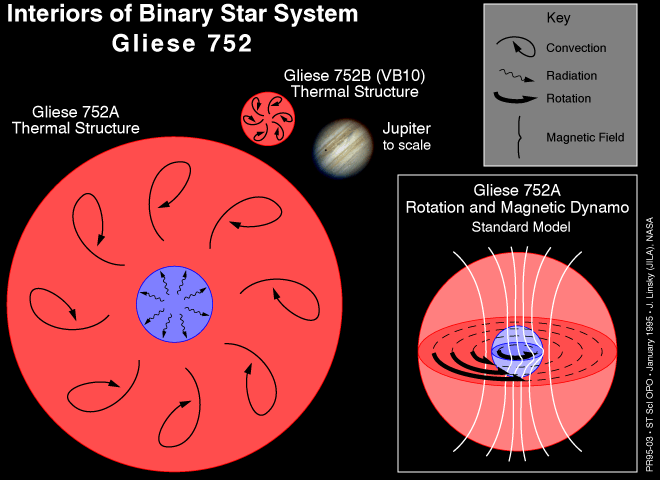Wolf 1055

Wolf 1055 (Gliese 752, Ross 652) is a binary system of two red dwarfs located 19.2 light-years away in the constellation Aquila, west of Altair (Alpha Aquilae) and north of Delta Aquilae. Both components, A and B, are flare stars. B is commonly referred to as Van Biesbröck's Star (VB10), after its discoverer, George van Biesbroeck and was once thought to be low enough in mass to be a possible brown dwarf. In fact, it is one of the dimmest red dwarfs known with a surface temperature of only 2,700 K and a diameter slightly less than that of Jupiter. In October 1994, while being observed with the Hubble Space Telescope's High Resolution Spectrograph, Van Biesbröck's Star produced a flare that temporarily heated its outer atmosphere to around 150,000 K.
| spectral type | luminosity | radius | mass | |
| Wolf 1055A | M3.5 Vne | 0.02 Lsun | 0.54 Rsun | 0.48 Msun |
| Wolf 1055B | M8 Ve | 0.00011 Lsun | 0.10 Rsun | 0.09 Msun |
Interior workings of a stellar dynamo
A team led by Jeffrey Linsky of the Joint Institute for Laboratory Astrophysics in Boulder, Colorado, used Hubble's Goddard High Resolution Spectrograph (GHRS) to make a one-hour long exposure of VB10 on 12 Oct ober 1994. No detectable ultraviolet emission was seen until the last five minutes, when bright emission was detected in a flare. Though the star's normal surface temperature is 4,500 °F, Hubble's GHRS detected a sudden burst of 270,000 °F in the star's outer atmosphere. Linsky attributes this rapid heating to the presence of an intense, but unstable, magnetic field.
Before the Hubble observation, astronomers thought magnetic fields in stars required the same dynamo process which creates magnetic fields on the Sun. In the classic solar model, heat generated by nuclear fusion reactions at the star's center escapes through a radiative zone just outside the core. The heat travels from the radiative core to the star's surface through a convection zone. In this region, heat bubbles to the surface by motions similar to boiling in a pot of water.
Dynamos, which accelerate electrons to create magnetic forces, operate when the interior of a star rotates faster than the surface. Recent studies of the Sun indicate its convective zone rotates at nearly the same rate at all depths. This means the solar dynamo must operate in the more rapidly rotating radiative core just below the convective zone.
The puzzle is that stars below 20% the mass of our Sun do not have radiative cores, but instead transport heat from their core through convection only. The new Hubble observations suggest a magnetic dynamo perhaps of a new type can operate inside these stars.


